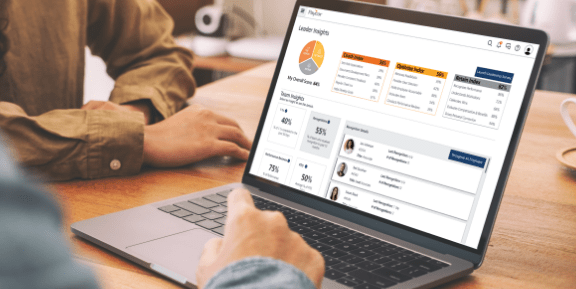A Human Resource Information System (HRIS), also referred to as Human Capital Management (HCM) software, is a powerful tool for your organization. It automates key HR functions and securely stores critical data.
But HR needs to be connected to every other arm of the organization. This interconnectivity is crucial, as employee data drives critical business decisions — from financial forecasting and operational planning to sales territory mapping and facility management.
Modern organizations can’t afford to have their HR systems operating in a silo. That’s where HRIS integration comes in. Read on for a complete guide to HRIS integration, including integration types, benefits, and more.
What is HRIS Integration?
HRIS integration refers to the process of connecting your HRIS with other software applications, allowing for automated data exchange and synchronized workflows across platforms. An integrated HRIS system creates a unified ecosystem in which information flows seamlessly between HR and other business functions, eliminating data silos and reducing manual data entry.
A recent Gartner survey shows less than one-quarter of HR employees report that their organization’s HR function is deriving the maximum value from HR technology. Integration helps maximize a software’s utility.
Types of HRIS Integration Systems
The types of HRIS integration systems are:
Internal
An internal integrated HR system means the HRIS integrates with other software used throughout the company to create a seamless exchange of data. This might include integration with your company’s financial software, document management systems, or internal communication platforms.
External
External HR system integration refers to when an HRIS integrates with an application or system outside of the company. This could include background check services, government reporting systems, or an external accounting system.
Best HRIS Integrations
Some of the best HRIS integrations include the following:
Payroll
HRIS and payroll go hand in hand. In fact, many HRIS software solutions include a payroll module. But for those that don’t, an integrated HRIS and payroll system proves crucial for streamlining HR processes and ensuring accurate data flow between employee records and compensation. Leading HRIS payroll integrations can automate tax calculations, deductions, direct deposits, and compliance reporting.
Benefits Administration
A robust benefits administration integration streamlines the complex process of managing employee benefits programs. Modern HRIS platforms integrate with benefits carriers and third-party administrators to automate enrollment, ensure accurate deductions, and maintain compliance. These integrations enable employees to self-select benefits through a single portal, while automatically syncing elections with payroll and carrier systems.
Talent Acquisition
Integrating talent acquisition with your HRIS streamlines the hiring process, from scheduling first interviews to onboarding new hires. For example, candidate data flows automatically into employee records upon hire. This seamless integration eliminates redundant data entry and reduces the risk of errors when converting candidates to employees.
Workforce Management
Workforce management integrations connect time and attendance, scheduling, and labor management systems with core HRIS platforms. These integrations ensure accurate time tracking, optimize staff scheduling, and provide real-time labor cost analysis. This integration category is particularly crucial for organizations with hourly workers or complex scheduling needs.
Learning Management
Modern HRIS platforms integrate with Learning Management Systems (LMS) to deliver and track employee training and development programs. These integrations enable automatic course assignments based on role or department, track completion rates, and maintain certification records. By connecting learning and development data with employee records, organizations can better manage compliance training and career development initiatives.
Productivity
HRIS integration with productivity and collaboration tools, like Google Workspace and Slack, helps streamline daily workflows and improve employee experience. These integrations can also facilitate easier sharing of HR-related documents, announcements, and communications while maintaining appropriate security and access controls.
Compliance
Compliance-focused integrations help organizations maintain adherence to various regulatory requirements and reporting obligations. By automating compliance processes and documentation, these integrations reduce risk. They also typically include built-in updates to accommodate changing regulations and reporting requirements.
Additional HRIS Integrations and Examples
Additional functions you can add into an HRIS integrated system include the following:
401(k)
HRIS integration with 401(k) and retirement plan administrators streamlines benefits management and ensures accurate contribution tracking. When integrated with 401(k) providers, the HRIS automatically syncs employee contribution elections, matches payroll deductions, and updates personal information across systems. This integration eliminates manual data reconciliation, reduces errors in contribution calculations, and provides employees with single sign-on access to view their retirement accounts.
POS
A point of sale (POS) integration is especially vital for service businesses, like restaurants, retail, and hotels. That’s because it lets them compare labor cost management based on real-time sales data. Managers can make data-driven decisions about scheduling by analyzing historical sales patterns alongside labor costs, ensuring optimal staffing levels during both busy and slow periods. This integration also simplifies tip reporting and distribution, ensuring accurate wage calculations and tax compliance for tipped employees.
ERP Systems
Enterprise Resource Planning (ERP) integration with HRIS creates a comprehensive business management solution. When HRIS platforms connect with ERP systems, organizations gain a unified view of human capital alongside other business resources. This integrated HR software enables better workforce planning by connecting HR data with financial forecasting, project management, and resource allocation.
Benefits of HRIS Integrations
HRIS integrations provide a key link between different functions in an organization’s operations, offering the following benefits for both employers and employees.
For Employers
- Improved data accuracy: With automated data synchronization between systems, there’s less room for human error and inconsistencies in employee records.
- Enhanced compliance: Integrated systems help ensure regulatory compliance by maintaining consistent data across platforms and automating required reporting.
- Informed analytics: Connected systems provide comprehensive data insights, enabling better decision-making through unified reporting and analytics capabilities.
- Cost savings: Streamlined processes and reduced administrative overhead lead to significant cost savings in both time and resources.
- Increased productivity: Automation of routine tasks allows HR teams to focus on more strategic initiatives and value-adding activities.
For Employees
- Better user experience: Employees can manage their information, benefits, and requests through a unified interface without switching between multiple systems.
- Faster service: Automated workflows and real-time data synchronization mean faster processing of requests and updates to employee information.
- Improved information access: Employees gain better visibility into their benefits, payroll, time off balances, and other HR-related information.
- Improved self-service: Integrated systems enable employees to handle many HR tasks independently, from updating personal information to enrolling in benefits.
- Real-time updates: Employees receive immediate confirmation of changes and updates across all integrated systems, ensuring they always have the most current information.
How to Choose the Best HRIS Integration Software
When evaluating HRIS software that offers integrations, you’ll want to consider a few factors to find the best fit for your needs. First off, does the system offer pre-built connectors with your existing software and third-party applications? For example, Paycor’s integration platform, the Marketplace, provides hundreds of pre-built connectors to best-in-class HCM vendor partners.
Does the software allow for custom integrations? Paycor offers developer tools that give you the ability to build complex, custom integrations, or developer services for resource-constrained organizations.
Lastly, ensure the integration platform can handle your current volume of data and transactions while accommodating future growth. Consider factors like API call limits, data storage capabilities, and the ability to add new integrations as your business needs evolve.
How to Integrate Your HRIS
Integrating an HRIS requires understanding the integration types and following a structured approach. Start by identifying your organization’s needs and existing systems to determine whether pre-builtor custom integrations are the best fit. Pre-built integrations connect easily with popular platforms, offering quick setup for standard workflows, while custom integrations provide flexibility for unique processes but may require more resources.
Next, evaluate the compatibility of the HRIS with your existing tools, like payroll or benefits systems, and ensure it aligns with your long-term goals. Collaborate with stakeholders to map out workflows and prioritize key functionalities. Test the integration in a controlled environment to address any technical issues before full deployment.
Finally, provide comprehensive training for your team, emphasizing the benefits of the integrated system. Offer ongoing support and monitor performance to identify opportunities for optimization as your business evolves.
Trends in HRIS Integration
The HRIS integration landscape is rapidly evolving, driven by technological advancements and changing workplace dynamics. Key trends shaping the industry include:
- AI: Artificial intelligence and machine learning are transforming HRIS integrations. Organizations are increasingly implementing AI-powered tools for talent acquisition, employee engagement analysis, and predictive analytics. 75% of employees say they used AI at work in 2024, but more than half were worried about AI replacing them and 46% were reluctant to admit they use it (CFO.com).
- Mobile-first solutions: With the rise of remote and hybrid work, mobile accessibility has become crucial. Organizations are prioritizing HRIS integrations that offer seamless mobile experiences, allowing employees to access HR functions from any device.
- Security and compliance: With increasing data privacy regulations, HRIS integrations are incorporating advanced security features. Multi-factor authentication, encryption, and automated compliance monitoring have become standard requirements for modern HR systems.
Future of HRIS Integration
The future of HRIS integration will likely be defined by unprecedented connectivity, smarter automation, and deeper personalization. HRIS platforms are expected to seamlessly integrate with emerging technologies like AI-powered virtual assistants that can guide employees through complex HR processes or answer routine questions. Machine learning will enable more sophisticated workforce analytics, offering actionable insights into productivity, engagement, and workforce planning.
Integration with wearable technology and IoT devices may also become commonplace, helping organizations monitor employee well-being and improve safety in real-time. Furthermore, as remote work continues to rise, future HRIS systems will likely prioritize hyper-secure, globally compliant integrations, ensuring smooth operations across borders.
Frequently Asked Questions
Still have questions abour HRIS Integration? Read on.
How Can HR Help During the Integration Process?
HR plays a key role by identifying organizational needs, mapping workflows, and collaborating with IT and vendors to ensure the HRIS aligns with business goals. They also support training, testing, and addressing employee concerns during the transition.
Is Paycor an HRIS Software Integration?
Yes, Paycor provides an all-in-one HRIS platform with integration capabilities, streamlining processes like payroll, benefits, and talent management.
What Integrated HRIS Software Does Paycor Offer?
Paycor offers integrated solutions for payroll, time tracking, employee benefits, talent management, and compliance, enabling businesses to manage HR functions efficiently in one platform.
Use Paycor for Your HRIS Integration
Paycor’s HR software gives you everything you need, from hire to retire, in a unified platform. Many popular integrations are already embedded in the software, such as:
- Payroll
- Benefits administration
- Talent acquisition
- Talent management
- Workforce management
- Compliance solutions
But for specific business needs or preferences, Paycor provides a three-part solution integration platform. The Paycor Marketplace provides hundreds of pre-built connectors to top HCM vendor partners. Our developer tools empower companies to build their own custom integrations. And for resource-constrained companies, we can scope, design, and build integrations for our customers.
Want to learn more about Paycor’s HCM product suite? Take a free guided product tour today.









